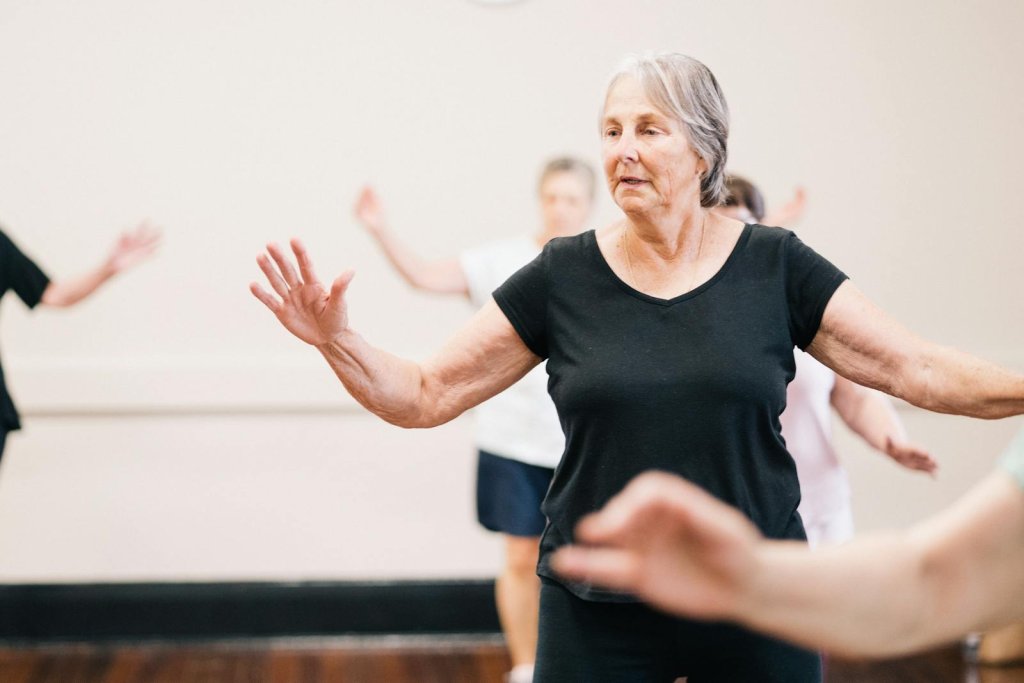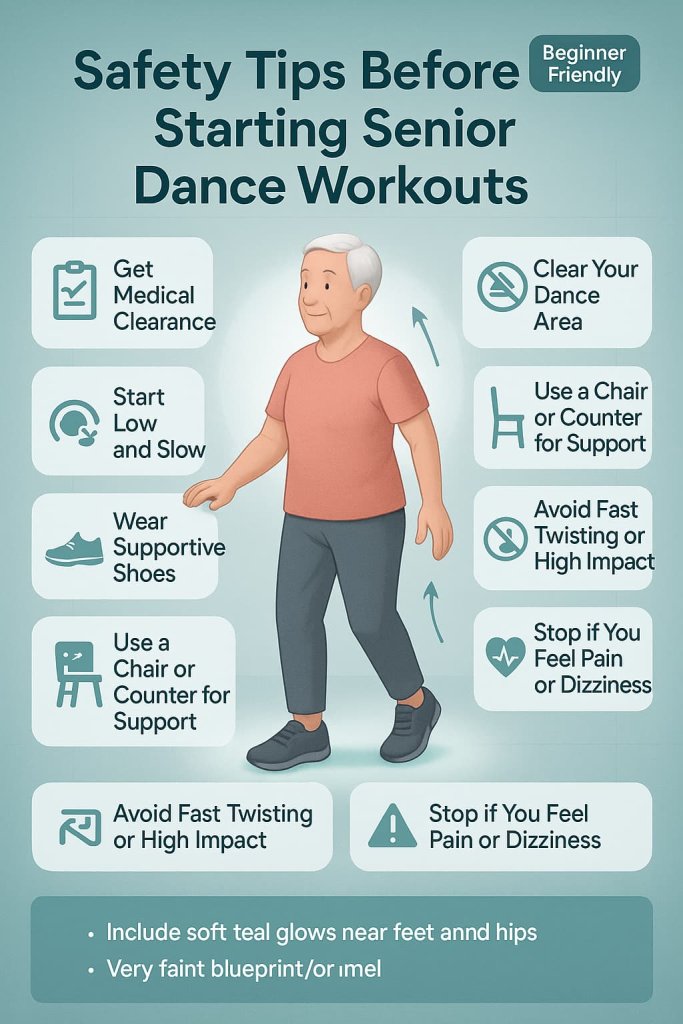The best dance exercises for seniors are low-impact, simple, rhythmic movements that raise the heart rate while protecting the joints and improving balance.
These include seated dance moves, step-touch patterns, line dancing basics, and senior-friendly programs like Zumba Gold.

Dance exercise for seniors matters because it helps support mobility, stability, confidence, and heart health—without the need for complex choreography. According to CDC and WHO guidelines, seniors benefit from at least 150 minutes of moderate activity weekly, and dance is one of the easiest ways to achieve that.
In this guide, you’ll find research-backed benefits, safety steps, and 13 senior-friendly dance exercises you can safely do at home.
Benefits of Dance Exercise for Seniors
Dance is one of the safest and most enjoyable ways for seniors to stay active because it is low-impact, rhythmic, and adaptable for all mobility levels. Research published in JAMA Network Open shows that dance-based mind-motor activities may help improve balance, mobility, and functional movement in older adults. Additional studies (Frontiers in Public Health, 2024) show benefits for lower-body strength, gait quality, and reduced fall risk.

Key benefits include:
- Improved balance and coordination
- Better joint mobility and flexibility
- Cardiovascular support at safe, moderate intensity
- Increased confidence in daily movement
- Support for cognitive engagement and memory
- Social and emotional well-being when done in groups
Dance provides both physical and cognitive stimulation—important for seniors who want to maintain independence and mobility.
Safety Tips Before Starting Senior Dance Workouts
Dance is safe for most older adults when performed correctly. To avoid injury and protect vulnerable joints:

- Get medical clearance if you have heart conditions, balance issues, or recent surgeries.
- Start low and slow: Begin with 5–10 minutes and progress gradually.
- Wear non-slip, supportive shoes to protect the feet and ankles.
- Keep your dance area clear of clutter, rugs, pets, or obstacles.
- Use a chair or countertop for balance support when learning new steps.
- Avoid fast twisting, quick turns, or high-impact movements.
- Stop immediately if you feel dizziness, chest pain, or shortness of breath.
13 Best Dance Exercises for Seniors (Step-by-Step Guide)
These beginner-friendly dance moves are low-impact, joint-safe, and simple to follow at any fitness level. Each exercise includes step-by-step instructions to help seniors stay active, balanced, and confident while moving to music.
1. Step-Touch Side to Side
Why it works:
This foundational dance step raises the heart rate gently while improving coordination and lateral movement—both essential for balance.
Muscles worked:
Glutes, quadriceps, hamstrings, calves, hip stabilizers, and shoulders (when arms swing).
How to do it:
- Step to the right.
- Bring your left foot in to meet the right.
- Step to the left.
- Bring your right foot in.
- Add gentle arm swings to increase intensity.
Trainer Tip:
Keep steps small and steady. Larger steps are optional once balance improves.
2. Marching With Arm Swings
Why it works:
Marching elevates heart rate without impact and helps train walking rhythm, gait, and cardiovascular endurance.
Muscles worked:
Hip flexors, quadriceps, calves, core, and shoulders.
How to do it:
- Stand tall with feet hip-width apart.
- Lift one knee to a comfortable height.
- Alternate knees at a steady pace.
- Swing arms naturally with the movement.
Trainer Tip:
If balance is a concern, march beside a sturdy counter for support.
3. Seated Upper-Body Dance Flow (Chair Dance)
Why it works:
Provides safe cardiovascular movement for seniors with mobility or balance limitations by focusing on rhythmic upper-body motion.
Muscles worked:
Shoulders, upper back, biceps, triceps, core, and torso stabilizers.
How to do it:
- Sit tall on a stable chair.
- Move your arms in rhythmic patterns (circles, waves, reaches).
- Add gentle torso turns or side bends to increase mobility.
- Keep movements smooth and controlled.
Trainer Tip:
Use a sturdy chair without wheels to prevent sliding.
4. Low-Impact Salsa Steps
Why it works:
Modified salsa improves coordination, rhythm, and balance without fast turns or twisting that can strain joints.
Muscles worked:
Hip flexors, glutes, quadriceps, calves, and core.
How to do it:
- Step forward with your right foot, then back.
- Step forward with your left foot, then back.
- Add gentle hip movement only if comfortable.
- Keep steps small and slow.
Trainer Tip:
Avoid sharp rotations; keep hips aligned with the torso.
5. Grapevine (Slow Version)
Why it works:
Enhances side-to-side mobility and coordination while challenging balance safely.
Muscles worked:
Hip stabilizers, glutes, quadriceps, hamstrings, and calves.
How to do it:
- Step to the right.
- Step your left foot behind your right.
- Step right again.
- Tap left foot lightly.
- Repeat on the other side.
Trainer Tip:
Hold a counter for support during the crossing step if needed.
6. Seated Leg Rhythmic Extensions
Why it works:
Supports lower-body mobility and circulation while keeping the body fully supported.
Muscles worked:
Quadriceps, hip flexors, and core stabilizers.
How to do it:
- Sit tall on a chair.
- Extend one leg forward to the rhythm.
- Lower it gently.
- Alternate legs while adding light arm motions.
Trainer Tip:
Move slowly if you have knee arthritis—avoid locking the knee.
7. Box Step (Slow Tempo)
Why it works:
A ballroom-inspired step that improves balance, coordination, and rhythmic foot placement.
Muscles worked:
Glutes, quads, hamstrings, calves, and core.
How to do it:
- Step forward with one foot.
- Step sideways with the other.
- Step back with the first foot.
- Bring feet together.
- Repeat on both sides.
Trainer Tip:
Keep steps small to avoid losing balance during directional changes.
8. Side Step with Arm Reach
Why it works:
Combines gentle cardio with mobility and flexibility through overhead or outward reaches.
Muscles worked:
Glutes, quads, shoulders, lats, and core.
How to do it:
- Step side to side at a slow pace.
- Reach one or both arms upward or outward.
- Maintain a comfortable range of motion.
Trainer Tip:
If reaching overhead feels unstable, reach forward or sideways instead.
9. Low-Impact Line Dance Basics
Why it works:
Rhythmic patterns build muscle memory, coordination, and cognitive engagement—important for brain health.
Muscles worked:
Glutes, quads, hamstrings, calves, hips, and core.
How to do it:
- Perform simple steps such as step-touch or marching.
- Add slow quarter turns only if comfortable.
- Keep movements smooth and low impact.
Trainer Tip:
Skip the turns if you have balance issues—keep the routine forward-facing.
10. Rhythm Walk (Forward & Back)
Why it works:
Trains gait, step length, and direction changes essential for daily movement and fall prevention.
Muscles worked:
Hip flexors, quads, hamstrings, calves, and core.
How to do it:
- Take 3–4 small steps forward.
- Take 3–4 steps backward.
- Maintain a steady rhythm.
- Keep strides short and controlled.
Trainer Tip:
Move near a wall or countertop when practicing backward steps.
11. Standing Hip Sway Dance Move
Why it works:
Gently mobilizes hips and torso while improving rhythm and body awareness.
Muscles worked:
Hip stabilizers, obliques, glutes, and core.
How to do it:
- Stand tall with soft knees.
- Shift hips right and left to the beat.
- Add light arm motions if comfortable.
Trainer Tip:
Keep movements slow—avoid fast hip swings to protect the lower back.
12. Gentle Twist + Step Combo
Why it works:
Encourages safe core mobility and coordination without stressing the spine.
Muscles worked:
Obliques, core stabilizers, hip flexors, and leg muscles.

How to do it:
- Step side to side at a slow tempo.
- Add a light torso turn toward the stepping foot.
- Keep the twist small and controlled.
Trainer Tip:
Avoid twisting through the knees—rotate gently from the torso only.
13. Zumba Gold Basic Steps
Why it works:
Zumba Gold incorporates simplified dance patterns that boost cardiovascular fitness while remaining joint-friendly for older adults.
Muscles worked:
Full body—hips, legs, arms, shoulders, and core.
How to do it:
- Follow simple moves like marching, salsa steps, and merengue.
- Keep pace slow and movements controlled.
- Modify steps to your comfort level.
Trainer Tip:
Choose routines labeled “Gold” or “beginner” to ensure senior-friendly intensity.
How Often Should Seniors Do Dance Exercise?
Most seniors benefit from:
- 3–5 days per week of moderate-intensity dance or other aerobic activity
- 10–15 minutes per session for beginners, progressing to 20–30 minutes
- Intensity where you can talk but not sing
- Combining dance with strength and balance training at least twice weekly (CDC & WHO guidelines)
Dance is flexible—you can break sessions into short 5–10 minute routines throughout the day.
Who Should Avoid or Modify Dance Exercise
Some seniors should modify or avoid certain dance movements depending on their health status:
- Those with severe osteoporosis should avoid quick twisting or bending.
- Seniors with advanced arthritis should skip deep knee bends and large hip rotations.
- Individuals with balance disorders, neuropathy, or vertigo should avoid moves requiring quick direction changes.
- Those with recent joint replacements should stick to seated or supported options until cleared by a clinician.
- Anyone with heart conditions should maintain a slow pace and monitor breathing.
Modifying steps—such as reducing range of motion or choosing seated options—helps ensure safety while still getting the benefits of movement.
FAQ: Dance Exercise for Seniors
1. Is dance safe for seniors over 70?
Yes—when movements are low-impact and performed at a comfortable pace. Medical clearance is recommended.
2. Can seniors with arthritis do dance workouts?
Yes, but only low-impact steps. Avoid jumps or fast twisting. Seated dance is a great option.
3. Does dance help seniors improve balance?
Research shows dance-based mind-motor activity may help improve balance and reduce fall risk.
4. How long should seniors dance for exercise?
10–30 minutes per session, depending on fitness level.
5. Can beginners with no dance experience follow these exercises?
Absolutely. These moves are simple, slow-paced, and designed for first-time dancers.
6. Is Zumba Gold good for seniors?
Yes. It is specifically designed for older adults, beginners, and those with limited mobility.
7. Can dance help support heart health for seniors?
Yes—dance counts as moderate aerobic activity when done at a steady pace.
Conclusion
Dance exercise for seniors provides a fun, low-impact way to stay active, support mobility, and improve confidence. Whether seated or standing, rhythmic movement helps strengthen key muscles, boost heart health, and improve coordination. Start small, keep movements simple, and enjoy staying active through music.
References
- Lu J et al. – The Effects of Dance Interventions on Physical Function and Quality of Life in Older Adults: A Systematic Review (2024)
https://pubmed.ncbi.nlm.nih.gov/38640093/ - McMaster Optimal Aging – Dance-Based Mind–Motor Activities and Healthy Older Adults (Evidence Summary)
https://www.mcmasteroptimalaging.org/full-article/es/healthy-older-adults-dance-based-mind-motor-activities-folk-ballroom-dancing-tai-3158 - NHS – Physical Activity Guidelines for Older Adults (65 and Over)
https://www.nhs.uk/live-well/exercise/physical-activity-guidelines-older-adults/
